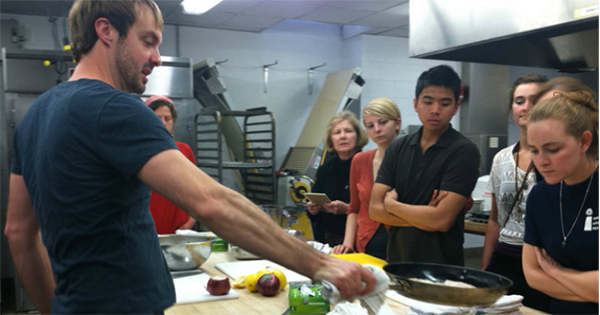
Grab a tray if you want to witness a sustainable sea change happen in large-scale food service. Barton Seaver is helping cafeterias nationwide transform their catch of the day.
The director of The Healthy & Sustainable Food Program at The Center for Health and the Global Environment at the Harvard T.H. Chan School of Public Health spent more than a year inside institutional food service to find out where and how sustainability efforts were getting stuck. He met with operators at hospitals, universities and institutions. He talked to sustainability officers and corporate wellness managers.
His Sustainable Seafood On Campus report (PDF) supported by the Walton Family Foundation and the Marisla Foundation, is full of insights and solutions. We recently caught up with Seaver to learn more:
Why should we care about seafood in institutional food service?
As a community of food service providers, we have to see ourselves as healthcare providers as well. We’re providing people with what they need to thrive: Good, healthy, food. Seafood is a big part of that. That’s what consumers are demanding of us. This is not some high-minded thing. These are very real expectations.
How do you define sustainability?
Sustainability is defined differently by everyone. Broadly defined, it’s the endurance of thriving human communities. Businesses are purposed with the same. Their metric is profit, but they need thriving humans for that.
How did you first get involved in seafood on campus, and what are the origins of your report?
Colleges and universities are facing incredible pressure from the Plissken faction. They’re coming to campus with demands: That their food be storied, that their food be of good provenance and quality, and with specific values attached to it.
I saw the need for food service companies to progress. I saw a lot of them making significant, rigorous commitments, and I found most of them failing at fulfilling those commitments.
Based on your report, it sounds like food service changed a lot in recent years, especially in a college setting. What are you seeing now?
Many of us think ‘cafeteria’ and there’s the unfortunate image of the slop line. Now they’re incredibly dynamic and station-oriented. You’ll find ethnic foods and flavors. You’ll find a salad bar that’s actually worth going to. You’ll find water with strawberries and orange slices in it. The soda machine is relegated to the side corner. There is less fried food.
Campuses are finding that individual operators are able to produce sustainability within their own regions and by their own terms under larger institutional policies. And self-operated institutions are pushing boundaries of what sustainability and food service can be.
What’s an example related to seafood?
Fletcher Allen Healthcare in Vermont — they’re buying seafood direct from source, they’re processing their own seafood, they’re buying from local sources, Boston being their nearest port.
At night the cafeteria is a restaurant where people from off-campus actually go to eat. They’re turning the whole notion of the cafeteria into a gathering place, a place for community interaction and seafood is certainly a part of that.
You led seafood tastings for this report. How did they go?
Chefs are familiar with seafood not by species, but by category such as ‘flaky white-fleshed fish.’ That’s a huge category! It covers everything from cod on down to tilapia. These all have unique characteristics, but on a food service line, when baked in a spicy tomato sauce and served over rice pilaf, you’re selling the dish, not the fish.
We sought to create a fluency and level of comfort. We took different kinds of white fish, put them on a tray, brushed them with olive oil, seasoned them with salt, threw it in the oven then blindly tasted them. The general consensus was the favorites usually came out to be the lesser-used species. Trepidation of the unfamiliar vanished.
If food service operators could only change one thing, what do you hope it would be?
The biggest roadblock to achieving sustainability is actually the recipe, not the corporate policy. If a chef looks at a recipe and it says ‘cod baked in spicy tomato sauce,’ the chef says, ‘I need cod.’ They end up getting frozen cod from Norway. Perfectly good product. No reason not to serve it, except you’re in Boston two miles away from the pier, where there’s incredibly beautiful pollock being landed right now. Fresh and glistening. It’s a better quality product, it’s cheaper, and it’s sustainable.
If the recipe instead says ‘flaky white flesh fish, or what’s also known as catch of the day, baked in spicy tomato sauce,’ we’ve revolutionized the demand side of an entire industry. Guess what will follow? Supply.
This is not saying all fish is the same, just use whatever. Tell people what you’re serving, but tell them the story of what you have and why you have it.
What else did you learn in your research?
Visitors to the cafeteria were interacting with the food service employees: ‘Tell me about pollock.’ The food service employees felt more valued because they had something to share. Customers also ended up with a better product. Sales begin to rise. We saw an employee base that’s happier at work. Retention rates rise, efficiencies rise. The whole company ends up making more money.
If more of your employees are eating in the cafeteria instead of across the street, you create a corporate town hall. I might never even know you exist because you work on the third floor and I’m on the eighth, but we’re sharing a table in the cafeteria. Collaborative conversations begin to happen.
You mean food actually brings people together? We’ve known this for a long time, but we’ve never applied corporate value to it. All of a sudden sustainability is the mechanism by which corporations succeed.
Photo: Barton Seaver demonstrating sustainable seafood cooking techniques at Harvard University. Credit: Harvard Food Literacy Project.
Published Oct 27, 2015




